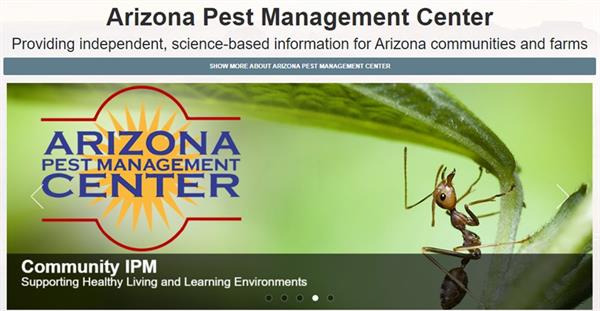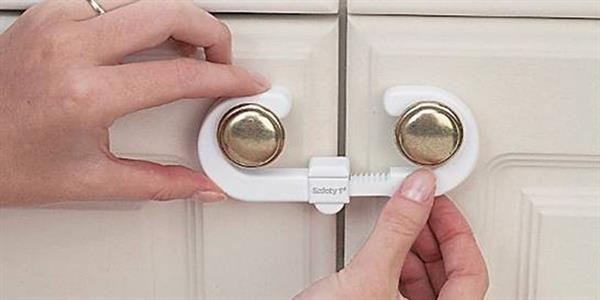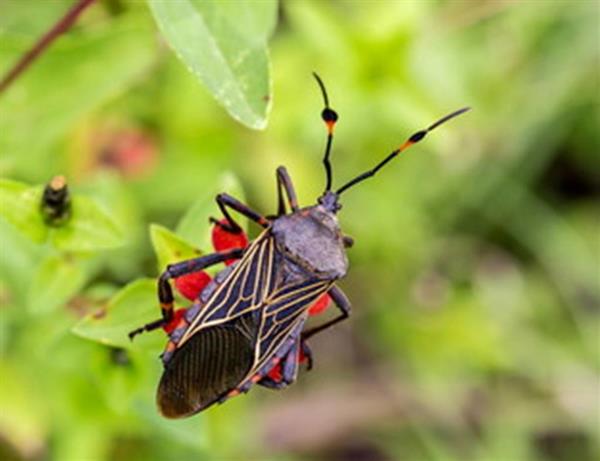
Shaku Nair1,, Shujuan Li1, Jennifer Weber2
1Department of Entomology, University of Arizona;
2University of Arizona, Pesticide Safety Education Program
What are pesticides?
According to the law, a pesticide is any substance "intended for preventing, destroying, repelling, or mitigating any pest." The term “pest” may refer to unwanted or harmful insects and other arthropods, microorganisms, plants, birds or animals.
It is important to realize that despite several misconceptions about pesticides, they can be important tools in a pest management plan. However, applying pesticides is not the only means to control pests. In many situations, pests can be effectively managed using non-chemical methods.
The most sensible, economical and sustainable method of pest management in any situation is integrated pest management or IPM.
“IPM is an ecologically-based pest management strategy that provides long-term management of pest problems with minimum impact on human health, the environment and non-target organisms.” – Arizona Pest Management Center. https://acis.cals.arizona.edu/about-us/arizona-pest-management-center

The Arizona Pest Management Center (APMC) is a multidisciplinary organization within the University of Arizona that represents, organizes and streamlines faculty pest management research and outreach. The APMC facilitates and supports efforts to develop and deliver outstanding Integrated Pest Management (IPM) programs that address the needs of Arizona’s citizens. This includes IPM programs serving agriculture, urban communities and natural areas. The APMC engages with faculty, partner organizations, clientele and other interested stakeholders to:
**************************************************************************
The Environmental Protection Agency (EPA) is an independent executive agency of the United States federal government tasked with environmental protection matters and is charged with ensuring that pesticides do not pose unreasonable risks to the public and to the environment. The EPA regulates the use of pesticides under the authority of two laws—the Federal Insecticide, Fungicide, and Rodenticide Act (FIFRA) and the Federal Food, Drug and Cosmetic Act (FFDCA). Most pesticides may legally be sold in the United States if they have been “registered” by EPA and if they bear an EPA registration number. Federal pesticide registration, however, is only the first step in preventing pesticide risks. Just as important are the steps that consumers take to control pests and use pesticides safely.
There is an increasing awareness of the benefits of IPM practices, as people realize the importance of environmental stewardship. However, this is also accompanied by changes in pest situations and management options due to new pest introductions and changes in availability of treatment measures such as pesticides.
There are many different types of pesticides; each is meant to be effective against specific pests. Some examples include:
Read more about different types of pesticides here: https://www.epa.gov/safepestcontrol/why-we-use-pesticides
One of the greatest causes of pesticide exposure to humans is the use of pesticides in and around the home. Consumers can buy a wide variety of “off the shelf” or “over-the-counter” pesticide products to control weeds, unwanted insects, and other pests. No special training is required before homeowners can use these pesticides in their homes or gardens. Yet, many of the products can be hazardous to people if they are stored, handled, applied, or disposed of improperly. Therefore, it is extremely important to practice safety when using pesticides so you can reduce risks of exposure to yourself, other people and the environment.
The basic steps in reducing pesticide risks are:

The EPA publication “Citizen’s Guide to Pest Control and Pesticide Safety” available here (https://www.epa.gov/sites/default/files/2017-08/documents/citizens_guide_to_pest_control_and_pesticide_safety.pdf) is designed to help answer citizen’s questions about pest control and pesticide safety and more.
The booklet provides information on how to control pests without risking your family’s health and without harming the environment. The major goals of this booklet are to help you understand
Pesticide Poisoning
Tens of thousands of pesticide poisonings are reported each year. Following a few simple steps can prevent many of these accidents. An EPA survey showed that almost half (47%) of households with young children and 75% of homes without young children had pesticides stored in unlocked cabinets within reach of children. Following a few simples steps, such as those outline below, can help prevent many of these accidents.
Pesticide Poisoning Prevention Tips from NPIC
The National Pesticide Information Center (NPIC) provides objective, science-based information about pesticides and pesticide-related topics to enable people to make informed decisions about pesticides and their use.
The Center operates through a cooperative agreement between Oregon State University and the U.S. Environmental Protection Agency. The NPIC website http://npic.orst.edu/about.html provides a variety of useful pesticide safety-related information, such as the pesticide poisoning prevention tips listed below.

Figure 1: Store pesticides in locked cabinets. Photo: Consumer Product Safety Commission.

Pesticide Safety Tips from the EPA
The Environmental Protection Agency (EPA) is an independent executive agency of the United States federal government tasked with environmental protection matters and is charged with ensuring that pesticides do not pose unreasonable risks to the public and to the environment. The EPA regulates the use of pesticides under the authority of two laws—the Federal Insecticide, Fungicide, and Rodenticide Act (FIFRA) and the Federal Food, Drug and Cosmetic Act (FFDCA). Most pesticides may legally be sold in the United States if they have been “registered” by EPA and if they bear an EPA registration number. Federal pesticide registration, however, is only the first step in preventing pesticide risks. Just as important are the steps that consumers take to control pests and use pesticides safely, such as:
The EPA provides a pesticide poison prevention checklist “Poison-proof Your Home: One Room at a Time”. Access the checklist here: https://www.epa.gov/sites/default/files/2015-10/documents/roombyroom-checklist.pdf

The EPA recommends and promotes integrated pest management (IPM) in schools, to reduce pesticide risk and exposure to children.
For more information on school IPM read: https://www.epa.gov/schools

The Border Tick and Rickettsia Surveillance (BiTeRS) program of the Pacific Southwest Center of Excellence in Vector-Borne Diseases (PacVec) offers services to enhance surveillance for ticks and tick-borne pathogens of human health concern in California and Arizona. This is made possible through our project leaders at the University of California, Davis, the University of Arizona, and collaborating local and state agencies, including the California Department of Public Health and the Arizona Department of Health Services.
We help every step of the way, and identification and pathogen testing are FREE. Collection supplies and protocols are provided, and partners receive all results on ticks they have submitted.
We work with partner organizations to:Partner organizations may be:
Download the BiTeRS Flyer for distribution: https://pacvec.us/biters/


Answer: An adult giant mesquite bug.
Congratulations to Master Pest Detectives
Bill Simonson, City of Glendale Water Services
Dave Lee, Gilbert Public Schools
Al Brown, Arizona State University
Karen Austermiller, Yavapai County Master Gardener

What does this image mean on a pesticide label?
If you know the answer, email Dawn at dhgouge@arizona.edu. You will not win anything if you are correct, but you will be listed as a “Master Pest Detective” in the next newsletter issue.
Upcoming Events
Horticultural Plant Pest and Disease Seminar at Maricopa County Cooperative Extension. Thursday, September 7th 8:00 am to 4:00 pm.
The seminar will feature a variety of talks and hands-on activities on pests and diseases of horticultural plants in Arizona landscapes; for landscapers, property managers, nursery growers and others engaged with the horticulture industry. 6 AZ Dept. of Ag. Agricultural (Ag.) and Structural PMD (OPM) CEUs are APPROVED!
Registration and schedule: https://tinyurl.com/2ujkwkcd.
For more information, contact Michael Chamberland, mchamb@arizona.edu or Shaku Nair, nairs@arizona.edu.
__________________________________________________
Save the Dates! Pest Management and Pesticide Safety Seminars for Turf and Landscapes. November 29th and 30th organized by the UA Turfgrass Science Program.
The seminars will be offered on two dates and locations, in person: November 29th at Sun City West and November 30th in East Valley (Location TBD). Both days will feature presentations by experts on various aspects of turf and landscape pest management and pesticide safety. Six AZ Dept. of Ag. Agricultural (Ag.) and Structural PMD (OPM) and GCSAA CEUs will be requested. Registration and more information coming soon! For more information, contact Shaku Nair nairs@arizona.edu.
**Please note change in dates from earlier announcements – Nov 29th in Sun City West, Nov 30th in East Valley.
__________________________________________________
What’s Bugging You? First Friday Events (New York State IPM Program)
Fridays | 12:00 pm. – 12:30 p.m. EDT | Zoom | Free; registration required
In this monthly virtual series, we explore timely topics to help you use integrated pest management (IPM) to avoid pest problems and promote a healthy environment where you live, work, learn and play. What is IPM? It's a wholistic approach that uses different tools and practices to not only reduce pest problems, but to also address the reasons why pests are there in the first place. Each month, our speakers will share practical information about how you can use IPM. Register for upcoming events.
What’s Bugging You First Friday events are in Spanish this year. Individuals interested in these events can find more information on this website: https://cals.cornell.edu/new-york-state-integrated-pest-management/outreach-education/events/whats-bugging-you-webinars/conozca-su-plaga
__________________________________________________
Urban and Community IPM Webinars University of California
UC Statewide IPM Program Urban and Community webinar series is held the third Thursday of every month to teach about pest identification, prevention and management around the home and garden. This series is free but advanced registration is required. Dates and topics below, all begin at noon Pacific. https://ucanr.edu/sites/ucipm-community-webinars/
__________________________________________________
View recordings of archived EPA Integrated Pest Management Webinars at https://www.epa.gov/managing-pests-schools/upcoming-integrated-pest-management-webinars.
For more information about the EPA Schools program: http://www.epa.gov/schools/.
To view previous University of Arizona newsletters, visit: https://acis.cals.arizona.edu/community-ipm/home-and-school-ipm-newsletters.
Acknowledgements
This material is in part funded by the National Institute of Food and Agriculture, U.S. Department of Agriculture, under award number 2021-70006-35385 that provides Extension IPM funding to the University of Arizona. It is funded in part by the USDA National Institute of Food and Agriculture through the Western Integrated Pest Management Center, grant number 2018-70006-28881. Additional support is provided by the UA Arizona Pest Management Center and Department of Entomology. Any opinions, findings, conclusions, or recommendations expressed in this publication are those of the authors and do not necessarily reflect the views of the U.S. Department of Agriculture or those of other funders.
We respectfully acknowledge the University of Arizona is on the land and territories of Indigenous peoples. Today, Arizona is home to 22 federally recognized tribes, with Tucson being home to the O’odham and the Yaqui. Committed to diversity and inclusion, the University strives to build sustainable relationships with sovereign Native Nations and Indigenous communities through education offerings, partnerships, and community service.